The Digital Sensor: A Guide to Understanding Digital Cameras
by Wesley Fink on April 21, 2008 1:00 AM EST- Posted in
- Digital Camera
Bayer vs. Foveon
This title is something of a misstatement, as it would more accurately be Foveon/Sigma versus everyone else in the world. All DSLR imaging sensors except the Foveon use Bayer technology. Digital color images are created by capturing red, blue, and green pixels and then combining them to create a full color image.
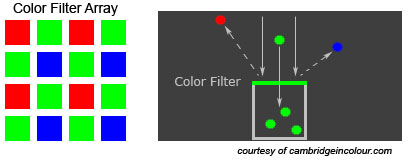
All current sensors except one use Bayer technology. The sensor consists of X megapixels, or light gathering cavities. The sensor is covered with a Bayer array, which is a series of microlenses that allow only certain colors to fall in certain cavities (or pixels). The microlenses are arranged in a defined grid that consists of alternating red-green and green-blue filters.
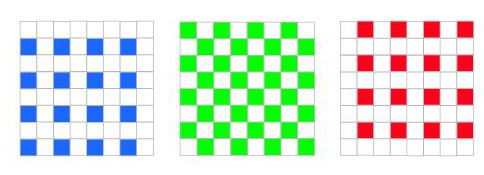
If you noticed there are twice as many green as red or blue areas in the above image, that is by design in the Bayer array. The human eye is more sensitive to green light than red or blue and the Bayer array uses this fact to produce images that appear to have finer detail and less noise. The doubling of the green receptors is corrected in the image processing.
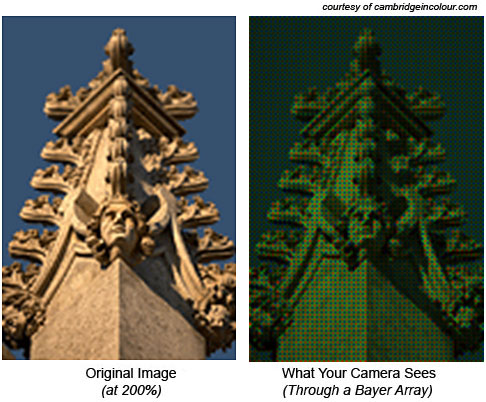
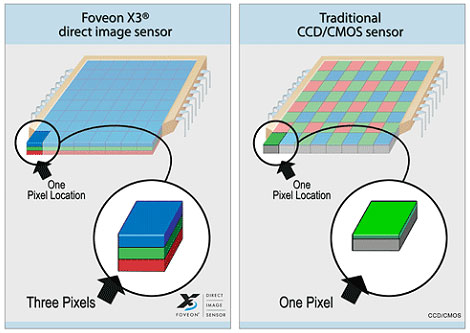
There is no demosaicing or interpolation step with the Foveon sensor. Where before there was one pixel of color information, the Foveon is now capturing red, green, and blue data pixels in the same pixel location. On the surface, this certainly appears a superior way of capturing color images, but things are not always as they appear. It is fair to ask: if this approach is so good then why is Sigma, a minor player in the digital camera market, the only company to embrace the Foveon sensor? A closer look at Foveon specs helps to understand some of the issues.
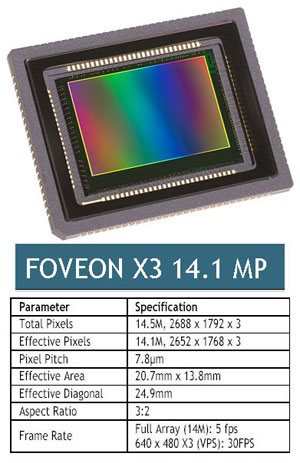
The top current Foveon sensor is the 14.1MP Foveon used in the Sigma SD14 digital camera. Foveon gets to the 14.1MP total by counting all pixels used to create the finished image, which is 2688x1768 pixels or 4.7MP. Many would argue this is fair since each pixel in a competing 14.1MP is only collecting one piece of color information. However, the practical reality is that a 14.1MP Foveon is reported to be about equivalent to an 8MP Bayer DSLR when shooting JPEGs and about as good a 10MP camera when shooting in the preferred and native RAW mode. The apparent resolution then is somewhere between the 4.7MP image size and the 14.1MP that are used to create that image.
Several other issues have also held back Foveon. Where the best Bayer cameras can now capture useful images at ISO 1600, 3200, or even higher, the Foveon sensor is best at lower ISOs. It is usable to about ISO 400 and then noise climbs rapidly as the ISO increases. The latest SD14 Foveon is reported to be better in ISO sensitivity, but it still falls far short of the extended ISO performance of its competition.
The other major issue with the Foveon sensor is that the separation into 3 distinct colors for each pixel site is not nearly as straightforward as Foveon describes it. The captured image still requires a lot of image processing to extract the 3 colors from each pixel site and reconstruct the finished image. In fact some critics claim the image processing required by the Foveon sensor is even more extensive than Bayer Array demosaicing. The purer the data in any extraction process the more faithful it is to the original capture, so the Foveon sensor may offer fewer "post-processing" advantages than it first appears. When conditions and lighting are correct the Foveon can deliver stunning images, but things in photography are rarely perfect.
For the purpose of our discussion the Foveon is more a novelty than a sensor you will likely use today. Despite its limited availability, however, the concept of the Foveon sensor is as compelling as ever, and you can actually buy a production camera, the Sigma SD14, that uses this sensor. As you can see from the specs, the sensor size is 20.7x13.8mm, which places the Foveon between the Canon small APS C and the Olympus 4/3 sensor. The lens multiplier is 1.7X.










72 Comments
View All Comments
Johnmcl7 - Monday, April 21, 2008 - link
On page 4:"The Foveon sensor falls between 4/4 and the Canon 1.6 in size and has a 1.7X lens multiplier."
I assume this should read '4/3'
Obvious question is what about Fuji? While I realise they re-use Nikon bodies and lenses, the discussion about Bater and Foveon makes no mention of Fuji's sensor. While it is more conventional than the Foveon, it's not just a bog standard bayer sensor and while Fuji are a minor player, so are Sigma.
For those who are not familiar with Fuji's design, they use two photodiodes at every point one larger and one smaller with the two combined to produce a single pixel in the output image. The idea is that these pair of pixels can capture more extended dynamic range than a standard bayer sensor of the same size. The latest version of this sensor is in the Fuji S5 Pro however it's limited to just 6MP although I can't remember if they still produce 12MP files from this. The S5 itself is basically a Fuji version of the very good Nikon D200 body although Nikon have of course moved on with the very impressive D300.
John
Wesley Fink - Monday, April 21, 2008 - link
Yes, it should have read 4/3 and the reference is corrected. The Fuji S3 was one of my favorite Nikon bodies and the dynamic range was certainly impressive in the studio.We did not mean to slight Fuji, but as one Nikon-mount body with a sensor that hasn't been updated in several years (the S3 and S5 sensors are the same as I understand it) we decided not to include the Fuji since there have been no sensor updates in quite a while.
Johnmcl7 - Monday, April 21, 2008 - link
"We did not mean to slight Fuji, but as one Nikon-mount body with a sensor that hasn't been updated in several years (the S3 and S5 sensors are the same as I understand it) we decided not to include the Fuji since there have been no sensor updates in quite a while. "I can't say I really agree there, given the article more focuses on concept in parts I think the S5 sensor is still relevent as it's something slightly different to the bayer sensor. The article refers to only Bayer and Foveon which implies there is nothing else, I think for completeness even if you don't go into any detail it's still worth mentioning Fuji are doing something else.
Also the S3 and S5 sensor are not the same, while they have the same amount of pixels it appears there's been some slight improvements although clearly not much. To be far to Fuji though, the Foveon sensor hasn't really come on much either - it's gone up very slightly in resolution with some small other changes but that's it pretty much. If the Foveon sensor had been just mentioned in passing I could definitely understand leaving Fuji with a similar mention but generally Fuji and Sigma are considered in the same boat as doing something a bit different although arguably with the Nikon body and mount Fuji have had more success.
John
melgross - Tuesday, April 22, 2008 - link
I never saw an advantage to their designs. I can't see what purpose having a smaller photo site on the sensor would do. It just has more noise, and less dynamic range than the larger sensor. I've read their papers on the subject, and they don't seem to have made a good case for it. Somehow, I think they understand that now.Johnmcl7 - Thursday, April 24, 2008 - link
"I never saw an advantage to their designs. I can't see what purpose having a smaller photo site on the sensor would do. It just has more noise, and less dynamic range than the larger sensor. I've read their papers on the subject, and they don't seem to have made a good case for it. Somehow, I think they understand that now."Are you referring to Fuji? If so, your information is incorrect - the last measurement I saw put the S5's sensor at slightly more dynamic range than the 35mm sensor in the Nikon D3. Their real problem at the moment seems to be resolution as well as having the older D200 based body.
John
strikeback03 - Tuesday, April 22, 2008 - link
I think Sigma (and Foveon) would be better off if Sigma could license a major player's mount, like Kodak did with the SLR/n and SLR/c. There are plenty of people who would like to have the sensor for the situations where it excels, but have no interest in a whole Sigma SA mount setup.pinto4402 - Monday, April 21, 2008 - link
I've been reading Anandtech for over 8 years now. I was a bit skeptical about your doing articles on digital cameras; however, this article put my reservations to rest. Very nicely done.I see why it makes sense for Anandtech to write about digital cameras. The nexus between computer tech and camera tech are very obvious if you've been following the trends. I'm a professional portrait photographer. In the last few years, it has become virtually impossible to remain in business unless you have a firm grasp on the latest camera tech as well as computer tech. I spend as much time on my computer as I do behind the camera. The camera has become a computer accessory (or vice versa). Many old timers who are hanging on to film are slowly being forced out. I'm somewhat of an old timer myself because I learned about photography when it was cool to have a darkroom, but I embraced digital equipment early.
Your graphs make it very easy to explain to people why their P&S (piece of s***) cameras are simply not adequate for serious portraiture. The MP count is marketing crap. As you demonstrated, it's the physical size of the sensor that matters.
Looking forward to part II of the series. Also, do you have any solid info on the introduction of 5D Mk II?
bjacobson - Tuesday, April 22, 2008 - link
"The MP count is marketing crap."Mostly. If you're willing to do some post processing yourself, the higher MP will enable you to decrease the IQ gap between the higher end DSLR and the ho-hum consumer camera. For this reason, since I wanted something compact and didn't really need a lot of optical zoom, I chose the Canon SD1100IS. 8MP, and while you begin to get noise at ISO400, more at ISO800, and tons at ISO1600, using a non-linear digital filter should correct most of that without blurring the image much (if at all).
strikeback03 - Wednesday, April 23, 2008 - link
Problem is that the camera has already blurred away lots of your detail at ISO 400 and up.http://www.dpreview.com/reviews/canonsd1100is/page...">http://www.dpreview.com/reviews/canonsd1100is/page...
Too bad there is no option to reduce/turn off the in-camera NR, for those of us who own a better program for it already.
Wesley Fink - Monday, April 21, 2008 - link
I wish I did have definitive info about the 5D Mark II launch, but the best info I have is this fall at Photokina. Rumors pop up every month that the new 5D will be here in a few weeks - and the last rumor was a definite April 22, which is tomorrow. Rumors are just that - rumors.